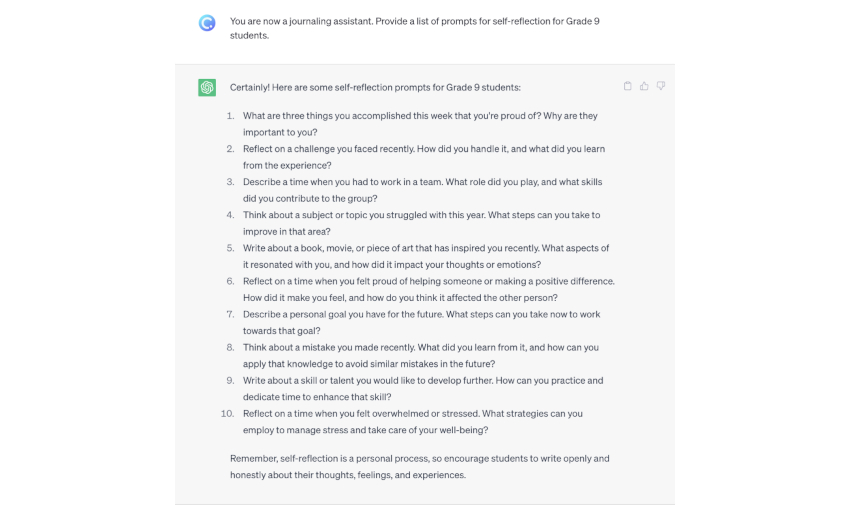11+ ChatGPT Prompt Examples to Download
ChatGPT has many uses in the academic setting, contexts, themes, and tones, which allows students, teachers, and other academics to utilize the Chatbot to improve their processes. Students and teachers can leverage and make use of ChatGPT prompts to help instruct the chatbot to enhance further their academic prowess, performance, and teaching skills. Therefore teachers must properly utilize the chatbot in their classrooms and lesson plans to not only better the teacher’s trade but to ensure the students are getting the best lessons they can.
1. ChatGPT Prompts to Research and Gather Relevant Content and Links for Lessons
A teacher can use ChatGPT to help provide them with up-to-date data, links, and resources they can use to augment their lessons on a specific topic or subject in their respective specialties. For example, a teacher can prompt ChatGPT to provide them with the most recent developments in health science and integrate the information into their lessons. The teacher needs to double-check and determine if the ChatGPT’s provided information is accurate and precise.
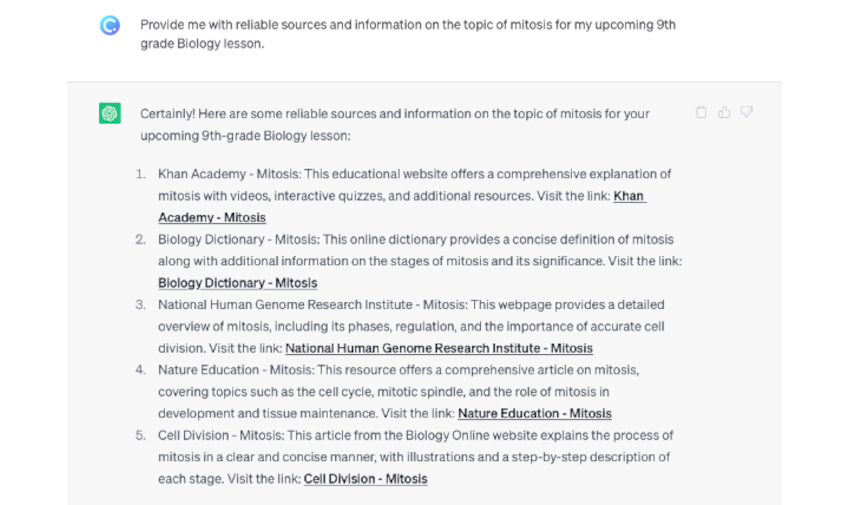
2. ChatGPT Prompts to Structure and Outline a Lesson Plan for Teachers
Lesson plans are pivotal for a teacher’s career and performance in their respective fields as it serves as the base structure and outline format for the teacher’s lessons in their time in the classroom with their students. Teachers can use ChatGPT to generate an efficient outline format or structure for a lesson plan the teacher can base their lesson plan on. Just note that the teacher will need to adapt and alter the generated lesson plan or its outline to better suit the needs of their students and teaching skills.
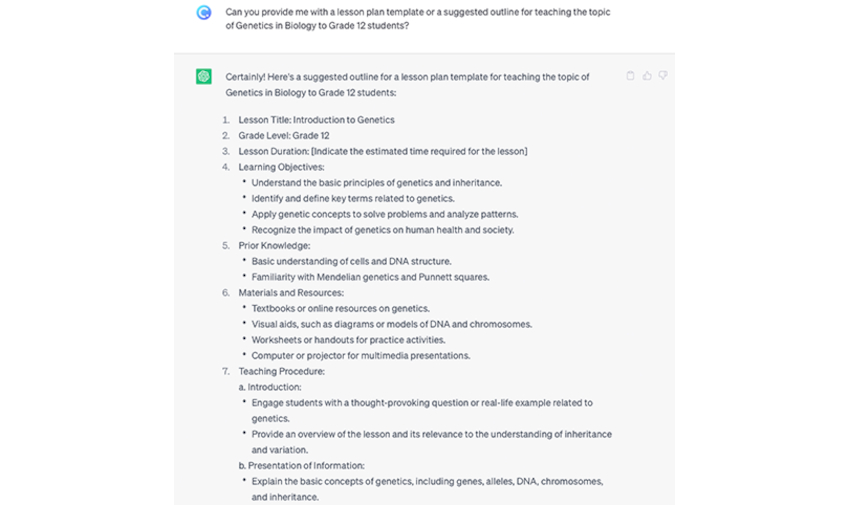
3. ChatGPT Prompts to Offer Ideas for Technology Tools and Platforms for Teachers to Use in the Classroom
Teachers and schools must have knowledge and understanding of modern tools, technology, and platforms that they can use, utilize, and incorporate into their lessons and teaching processes, A teacher or faculty member can use ChatGPT to help let them understand the current technology, modern teaching strategies, and teaching platforms that can improve the quality of learning the students can obtain in their time in the school. For example, the faculty member can prompt ChatGPT to produce ten computer software programs they can use to update their lesson plans.

4. Generate Discussion and Lesson Prompts through the Use of ChatGPT Prompts
In schools, teachers have to encourage students to have an understanding of specific real-life concepts and apply logic or logical reasoning to the said concept. One of the best ways a teacher can facilitate that understanding is to generate and use discussion questions and encourage the students to think for themselves on a specific concept or subject. A teacher can prompt ChatGPT to generate discussion questions or lesson prompts that can stimulate a discourse about a specific topic.
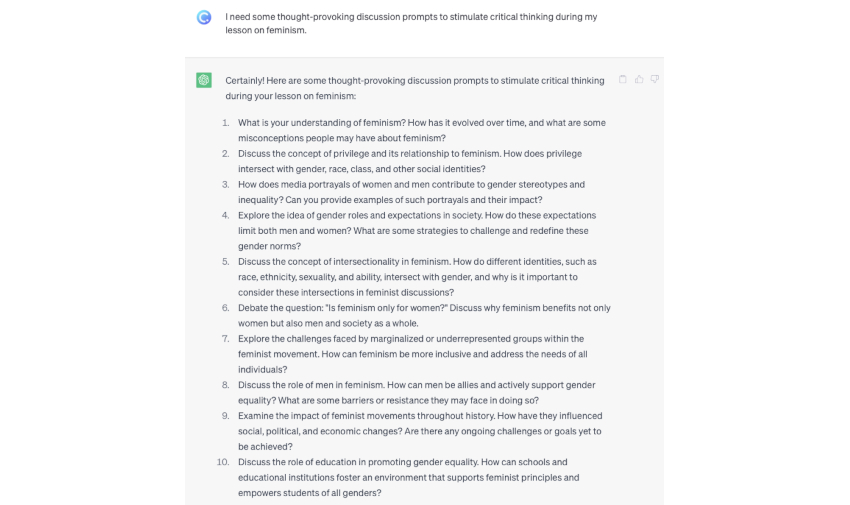
5. Using ChatGPT Prompts to Create and Generate Worksheets and Exercises Instantly
Worksheets and exercises are physical or digital tests or exams that test out the student’s current level of understanding and knowledge on a specific topic or subject. A teacher can use ChatGPT to generate or create a structure, outline, or worksheet questions instantly, which will not only reduce the amount of time and effort the teacher will need to provide. For example, a teacher can prompt ChatGPT to create twenty multiple-choice questions on the topic of Newton’s first law of motion, which will include some mathematical concepts of the said Physics topic.
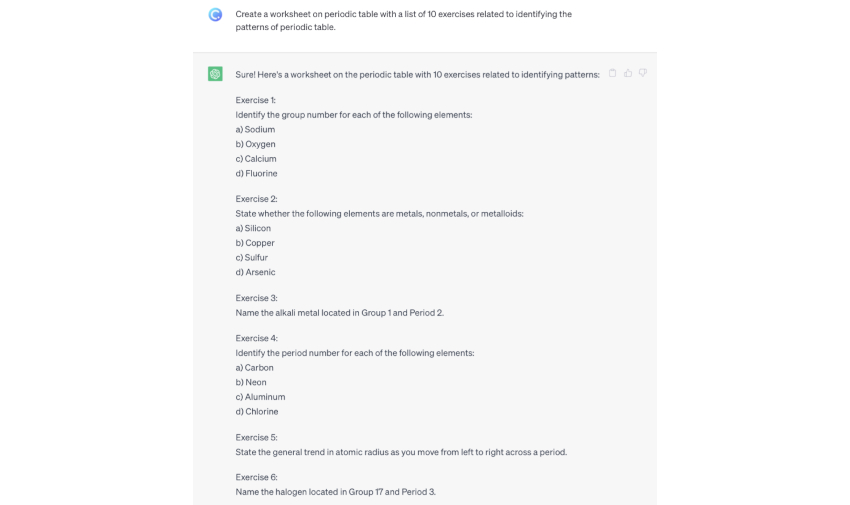
6. Using ChatGPT Prompts to Obtain Effective Research Methodologies and Data Collection Techniques
Research is a person’s application to the scientific method, which will require the person to theorize and gather evidence through various quantitative and qualitative methodologies. Teachers can use ChatGPT to help relay to students different ways to obtain effective research methodologies and data collection techniques, which will help the student in their effort to research a specific research question. For example, a teacher can prompt ChatGPT to provide the students with effective survey and survey questions techniques that can provide accurate data.
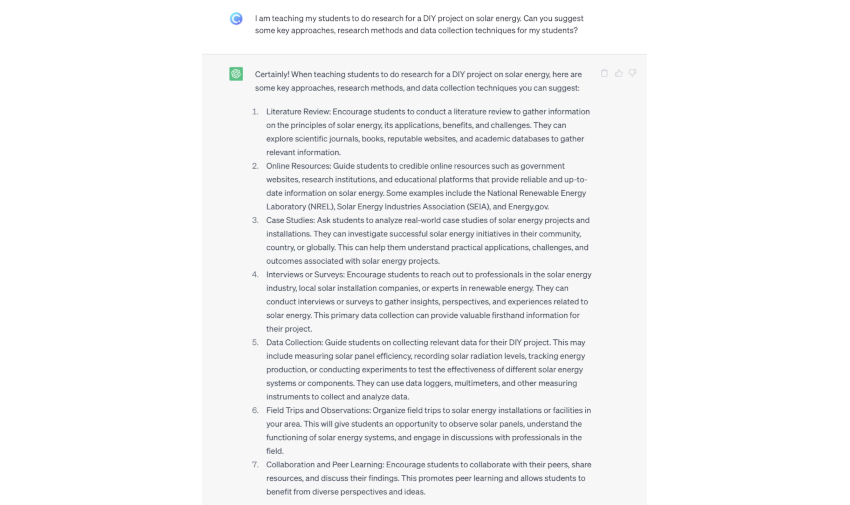
7. ChatGPT can Generate Hypothetical Scenarios to Fuel the Brainstorming Process
Hypothetical scenarios allow the teachers and students to have a discourse on the practical choices they can have on the specific scenario without the need for the event to physically occur. Teachers can use ChatGPT to generate hypothetical scenarios that will teach and fuel the student’s hard skill of brainstorming. For example, an ethics teacher can use ChatGPT to create a list of five hypothetical scenarios they can use in their ethics lesson on consent.

8. Using ChatGPT to Create a Concept Exploration for a Teacher’s Class or Lesson
Complicated and complex concepts can take a long time for a student to understand in the classroom, which may result in the student having a difficult time or situation in the classroom. A teacher can use ChatGPT to create descriptions or conduct a concept exploration of a specific complicated or complex subject which will allow students to easily digest and understand the complicated and complex concepts.
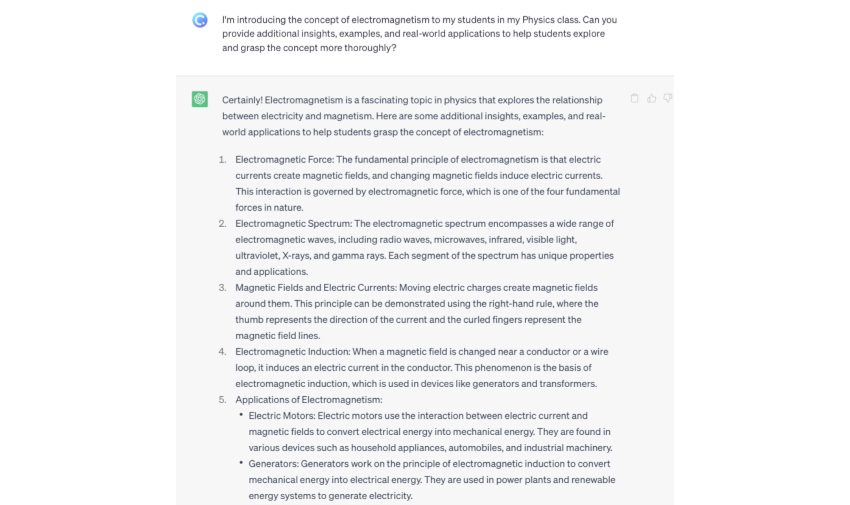
9. Using ChatGPT Prompts to Conduct Mind-Mapping Sessions to Reinforce Learning and Understanding
Mind mapping is a learning technique that allows students to engage in different styles of learning through the use of creativity and artistic expression as a way to take down notes. A teacher can use ChatGPT to help students learn and conduct mind-mapping exercises and sessions that will facilitate this specific type of studying or note-taking technique without any room for difficulty. For example, a teacher can prompt ChatGPT to provide an example of a mind map on a specific topic.
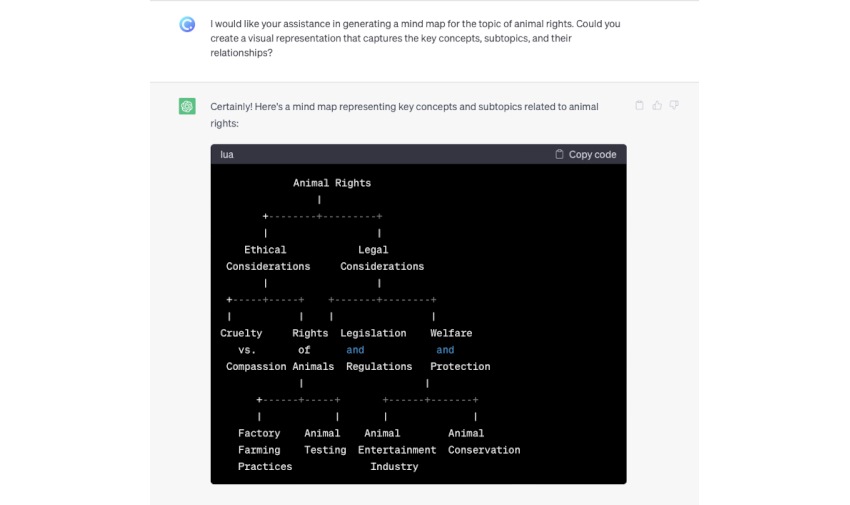
10. Using ChatGPT Prompts to Translate Specific Phrases to Different Languages
Some teachers work in schools that specifically cater to students of different nationalities and languages, like ESL or English as a Second Language teachers. These types of teachers can use ChatGPT to help cater to these specific foreign students and send them texts in their native language to help them understand instructions or assignments. For example, an ESL teacher can prompt ChatGPT to provide a translation for “Please send the assignment by 9 PM tonight” in Chinese.”
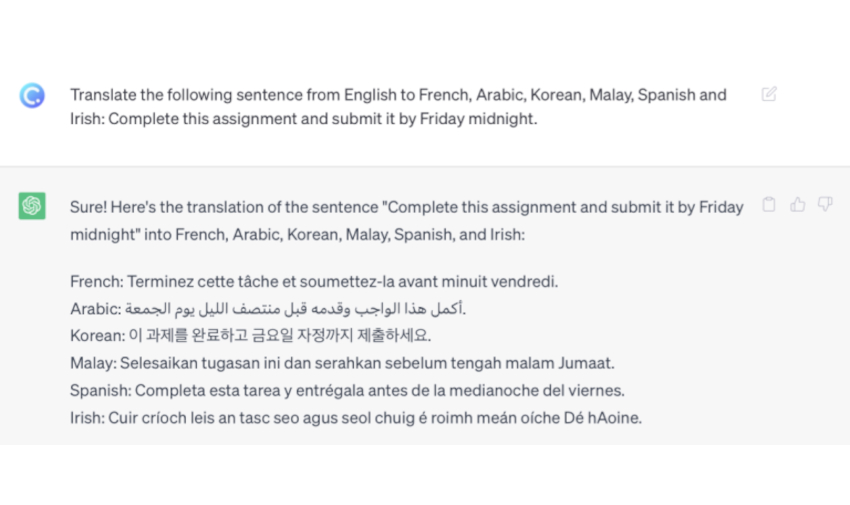
11. Using ChatGPT Prompts to Provide Comprehensive Reading Lists
One of the best ways for students to learn is to read books and research that both engage the reader and comprehensively present the information stored within the text. A teacher can use ChatGPT to help provide students with a comprehensive reading list full of engaging and attention-grabbing books and resources. For example, a science teacher can prompt ChatGPT to provide a comprehensive and fun reading list about plants for grade three students in ChatGPT.
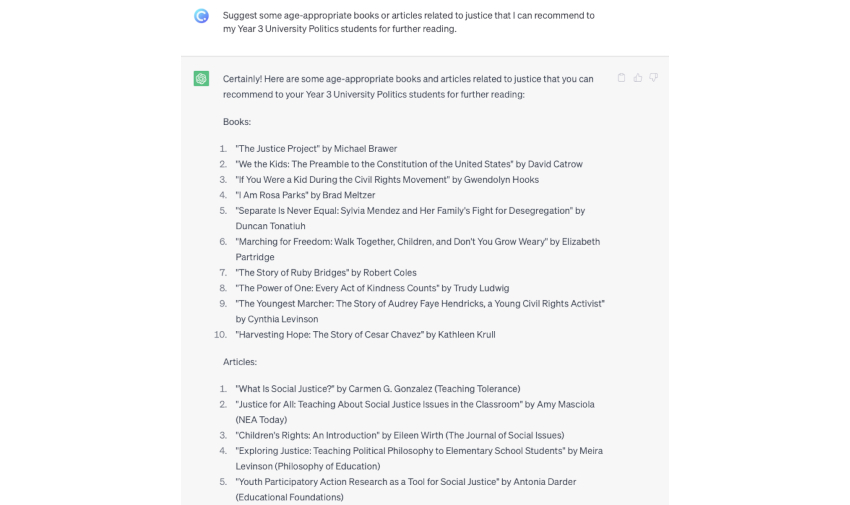
12. Using ChatGPT to Provide Students with Journaling and Essay Prompts
Journaling is the act of writing one’s thoughts and daily activities in a journal as a way to destress and note down all the significant things that have occurred in the day. Not only that, but the journal allows the person to also note down their feelings about a specific topic or subject. A teacher can use ChatGPT to provide students with journaling and essay prompts.
What Is the Use of ChatGPT for Teachers?
Teachers can use ChatGPT in numerous ways that can benefit both their students and themselves, which is wholly dependent on the quality of the teacher’s usage of ChatGPT. For example, if a teacher does not properly check ChatGPT’s generated content, they may spread misinformation, fallacies, or false information to their students, which might lead to biased or misinformed decisions. The teacher can use ChatGPT to help inform the students of complex topics, the creation and usage of mind maps, the translation of texts from books of other languages, and more.
How to Properly Use ChatGPT as a Teacher
There is a great need for the teacher to understand the nature and usage of ChatGPT in the academic context, as improper use may result in a lot of negative consequences. ChatGPT is a generative chatbot that can create dialogues that cater to the need of its target market. This is due to the chatbot’s generative nature, there are times when the chatbot will spread wrong information or not understand the prompt. If you want to learn examples of ChatGPT usage for teachers, you may use any of the headers and examples above.
Step 1: Brush Up or Have Basic Knowledge and Understanding of The Topic You are Teaching
Start by brushing up or having basic knowledge and understanding of the topic you are teaching and will be using ChatGPT on, as the generative nature of the content might feed misinformed or misinterpreted data to you. This basic knowledge and understanding should act as the basis or structure you will use to understand the content ChatGPT generates and will determine the viability and usage of the generated content.
Step 2: Learn How to Create or Make Specific ChatGPT Prompts
ChatGPT prompts serve as the instructions one will feed to ChatGPT’s AI or algorithm, which will allow the chatbot to produce your desired output. The quality of one’s ChatGPT prompts has a direct impact on the quality, accuracy, and precision of the content ChatGPT will generate for you. You must learn how to create specific ChatGPT prompts that will allow you to obtain your desired output.
Step 3: Create or Outline a Standard Guide for the Generated Content You Will Use
Having a standard or a standard guide for the content you will accept from ChatGPT will not only help filter and outline the content you will use, but it will also ensure that you do not get information or data that is useless or misinformed. Therefore you must outline or format a standard guide that will illustrate the quality of content you will take from ChatGPT.
Step 4: Learn How to Properly Integrate the Generated Content into One’s Lessons or Lesson Plan
You need to learn how to properly integrate and utilize ChatGPT’s content into one’s lessons or lesson plan. You must not simply copy and paste the content ChatGPT presents to you, and instead alter and adapt the content to your lesson plan, objectives, learning goals, and teaching strategies. Doing all of this will not only allow you to improve your teaching skills but will also create an efficient teaching process that will save you a lot of time and effort.
FAQs
Should I proofread any of the contents of the ChatGPT-generated lesson plan?
Yes, you should proofread and double-check the contents ChatGPT will generate for your lesson plan, as it may have mistakes in pacing, subject matter, and subtopics. If it will have flawed information or pacing, the lesson plan will not only fail, but it will also ruin the student’s understanding and grasp of the lesson you will teach. Therefore, it is important to proofread any or all of the contents ChatGPT will generate for your lesson plan, as it is very pivotal to the success of your teaching career.
Can I use ChatGPT to produce practical examples for my students?
Yes, you can let ChatGPT produce practical examples of one’s topic for the students, which will allow them to relate to and understand the topic better. But you will need to moderate the examples ChatGPT provides as it will create examples that will not cover or misrepresent the topic. You can also use your own experiences to provide real-life examples to your students to also make the topic easier to understand.
Should I copy the generated contents of ChatGPT in my lessons?
No, you should not just simply copy the generated contents of ChatGPT and use it in your lessons. It is important to understand that ChatGPT generates the content using the algorithm’s database as a structure, which might have outdated or wrong information. Instead, you should adapt and properly double-check the generated contents of ChatGPT and adapt it to your lessons.
Teachers who can properly utilize ChatGPT in their lessons and teaching skills can create efficient teaching and learning processes and high-quality lessons to ensure the future of their students. To properly do all of this, the teacher must properly understand and know the nature of ChatGPT and the correct usage of ChatGPT for teachers.
11+ ChatGPT Prompt Examples to Download

ChatGPT has many uses in the academic setting, contexts, themes, and tones, which allows students, teachers, and other academics to utilize the Chatbot to improve their processes. Students and teachers can leverage and make use of ChatGPT prompts to help instruct the chatbot to enhance further their academic prowess, performance, and teaching skills. Therefore teachers must properly utilize the chatbot in their classrooms and lesson plans to not only better the teacher’s trade but to ensure the students are getting the best lessons they can.
1. ChatGPT Prompts to Research and Gather Relevant Content and Links for Lessons
A teacher can use ChatGPT to help provide them with up-to-date data, links, and resources they can use to augment their lessons on a specific topic or subject in their respective specialties. For example, a teacher can prompt ChatGPT to provide them with the most recent developments in health science and integrate the information into their lessons. The teacher needs to double-check and determine if the ChatGPT’s provided information is accurate and precise.

2. ChatGPT Prompts to Structure and Outline a Lesson Plan for Teachers
Lesson plans are pivotal for a teacher’s career and performance in their respective fields as it serves as the base structure and outline format for the teacher’s lessons in their time in the classroom with their students. Teachers can use ChatGPT to generate an efficient outline format or structure for a lesson plan the teacher can base their lesson plan on. Just note that the teacher will need to adapt and alter the generated lesson plan or its outline to better suit the needs of their students and teaching skills.

3. ChatGPT Prompts to Offer Ideas for Technology Tools and Platforms for Teachers to Use in the Classroom
Teachers and schools must have knowledge and understanding of modern tools, technology, and platforms that they can use, utilize, and incorporate into their lessons and teaching processes, A teacher or faculty member can use ChatGPT to help let them understand the current technology, modern teaching strategies, and teaching platforms that can improve the quality of learning the students can obtain in their time in the school. For example, the faculty member can prompt ChatGPT to produce ten computer software programs they can use to update their lesson plans.

4. Generate Discussion and Lesson Prompts through the Use of ChatGPT Prompts
In schools, teachers have to encourage students to have an understanding of specific real-life concepts and apply logic or logical reasoning to the said concept. One of the best ways a teacher can facilitate that understanding is to generate and use discussion questions and encourage the students to think for themselves on a specific concept or subject. A teacher can prompt ChatGPT to generate discussion questions or lesson prompts that can stimulate a discourse about a specific topic.

5. Using ChatGPT Prompts to Create and Generate Worksheets and Exercises Instantly
Worksheets and exercises are physical or digital tests or exams that test out the student’s current level of understanding and knowledge on a specific topic or subject. A teacher can use ChatGPT to generate or create a structure, outline, or worksheet questions instantly, which will not only reduce the amount of time and effort the teacher will need to provide. For example, a teacher can prompt ChatGPT to create twenty multiple-choice questions on the topic of Newton’s first law of motion, which will include some mathematical concepts of the said Physics topic.

6. Using ChatGPT Prompts to Obtain Effective Research Methodologies and Data Collection Techniques
Research is a person’s application to the scientific method, which will require the person to theorize and gather evidence through various quantitative and qualitative methodologies. Teachers can use ChatGPT to help relay to students different ways to obtain effective research methodologies and data collection techniques, which will help the student in their effort to research a specific research question. For example, a teacher can prompt ChatGPT to provide the students with effective survey and survey questions techniques that can provide accurate data.

7. ChatGPT can Generate Hypothetical Scenarios to Fuel the Brainstorming Process
Hypothetical scenarios allow the teachers and students to have a discourse on the practical choices they can have on the specific scenario without the need for the event to physically occur. Teachers can use ChatGPT to generate hypothetical scenarios that will teach and fuel the student’s hard skill of brainstorming. For example, an ethics teacher can use ChatGPT to create a list of five hypothetical scenarios they can use in their ethics lesson on consent.

8. Using ChatGPT to Create a Concept Exploration for a Teacher’s Class or Lesson
Complicated and complex concepts can take a long time for a student to understand in the classroom, which may result in the student having a difficult time or situation in the classroom. A teacher can use ChatGPT to create descriptions or conduct a concept exploration of a specific complicated or complex subject which will allow students to easily digest and understand the complicated and complex concepts.

9. Using ChatGPT Prompts to Conduct Mind-Mapping Sessions to Reinforce Learning and Understanding
Mind mapping is a learning technique that allows students to engage in different styles of learning through the use of creativity and artistic expression as a way to take down notes. A teacher can use ChatGPT to help students learn and conduct mind-mapping exercises and sessions that will facilitate this specific type of studying or note-taking technique without any room for difficulty. For example, a teacher can prompt ChatGPT to provide an example of a mind map on a specific topic.

10. Using ChatGPT Prompts to Translate Specific Phrases to Different Languages
Some teachers work in schools that specifically cater to students of different nationalities and languages, like ESL or English as a Second Language teachers. These types of teachers can use ChatGPT to help cater to these specific foreign students and send them texts in their native language to help them understand instructions or assignments. For example, an ESL teacher can prompt ChatGPT to provide a translation for “Please send the assignment by 9 PM tonight” in Chinese.”

11. Using ChatGPT Prompts to Provide Comprehensive Reading Lists
One of the best ways for students to learn is to read books and research that both engage the reader and comprehensively present the information stored within the text. A teacher can use ChatGPT to help provide students with a comprehensive reading list full of engaging and attention-grabbing books and resources. For example, a science teacher can prompt ChatGPT to provide a comprehensive and fun reading list about plants for grade three students in ChatGPT.

12. Using ChatGPT to Provide Students with Journaling and Essay Prompts
Journaling is the act of writing one’s thoughts and daily activities in a journal as a way to destress and note down all the significant things that have occurred in the day. Not only that, but the journal allows the person to also note down their feelings about a specific topic or subject. A teacher can use ChatGPT to provide students with journaling and essay prompts.
What Is the Use of ChatGPT for Teachers?
Teachers can use ChatGPT in numerous ways that can benefit both their students and themselves, which is wholly dependent on the quality of the teacher’s usage of ChatGPT. For example, if a teacher does not properly check ChatGPT’s generated content, they may spread misinformation, fallacies, or false information to their students, which might lead to biased or misinformed decisions. The teacher can use ChatGPT to help inform the students of complex topics, the creation and usage of mind maps, the translation of texts from books of other languages, and more.
How to Properly Use ChatGPT as a Teacher
There is a great need for the teacher to understand the nature and usage of ChatGPT in the academic context, as improper use may result in a lot of negative consequences. ChatGPT is a generative chatbot that can create dialogues that cater to the need of its target market. This is due to the chatbot’s generative nature, there are times when the chatbot will spread wrong information or not understand the prompt. If you want to learn examples of ChatGPT usage for teachers, you may use any of the headers and examples above.
Step 1: Brush Up or Have Basic Knowledge and Understanding of The Topic You are Teaching
Start by brushing up or having basic knowledge and understanding of the topic you are teaching and will be using ChatGPT on, as the generative nature of the content might feed misinformed or misinterpreted data to you. This basic knowledge and understanding should act as the basis or structure you will use to understand the content ChatGPT generates and will determine the viability and usage of the generated content.
Step 2: Learn How to Create or Make Specific ChatGPT Prompts
ChatGPT prompts serve as the instructions one will feed to ChatGPT’s AI or algorithm, which will allow the chatbot to produce your desired output. The quality of one’s ChatGPT prompts has a direct impact on the quality, accuracy, and precision of the content ChatGPT will generate for you. You must learn how to create specific ChatGPT prompts that will allow you to obtain your desired output.
Step 3: Create or Outline a Standard Guide for the Generated Content You Will Use
Having a standard or a standard guide for the content you will accept from ChatGPT will not only help filter and outline the content you will use, but it will also ensure that you do not get information or data that is useless or misinformed. Therefore you must outline or format a standard guide that will illustrate the quality of content you will take from ChatGPT.
Step 4: Learn How to Properly Integrate the Generated Content into One’s Lessons or Lesson Plan
You need to learn how to properly integrate and utilize ChatGPT’s content into one’s lessons or lesson plan. You must not simply copy and paste the content ChatGPT presents to you, and instead alter and adapt the content to your lesson plan, objectives, learning goals, and teaching strategies. Doing all of this will not only allow you to improve your teaching skills but will also create an efficient teaching process that will save you a lot of time and effort.
FAQs
Should I proofread any of the contents of the ChatGPT-generated lesson plan?
Yes, you should proofread and double-check the contents ChatGPT will generate for your lesson plan, as it may have mistakes in pacing, subject matter, and subtopics. If it will have flawed information or pacing, the lesson plan will not only fail, but it will also ruin the student’s understanding and grasp of the lesson you will teach. Therefore, it is important to proofread any or all of the contents ChatGPT will generate for your lesson plan, as it is very pivotal to the success of your teaching career.
Can I use ChatGPT to produce practical examples for my students?
Yes, you can let ChatGPT produce practical examples of one’s topic for the students, which will allow them to relate to and understand the topic better. But you will need to moderate the examples ChatGPT provides as it will create examples that will not cover or misrepresent the topic. You can also use your own experiences to provide real-life examples to your students to also make the topic easier to understand.
Should I copy the generated contents of ChatGPT in my lessons?
No, you should not just simply copy the generated contents of ChatGPT and use it in your lessons. It is important to understand that ChatGPT generates the content using the algorithm’s database as a structure, which might have outdated or wrong information. Instead, you should adapt and properly double-check the generated contents of ChatGPT and adapt it to your lessons.
Teachers who can properly utilize ChatGPT in their lessons and teaching skills can create efficient teaching and learning processes and high-quality lessons to ensure the future of their students. To properly do all of this, the teacher must properly understand and know the nature of ChatGPT and the correct usage of ChatGPT for teachers.


